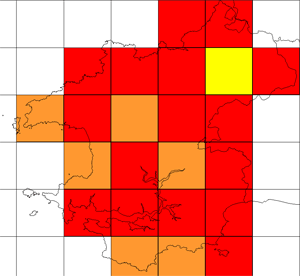Breeding summer visitor, passage migrant and winter visitor
Mathew (1894) classified the Blackcap as a summer visitor that was far from common, with a few pairs in the north-east of the county, also noting that it was "stated to be common in the extreme south". Lockley etal. (1949) regarded it as a "fairly common" summer resident which appeared on the islands on spring migration but rarely in autumn.
Today they breed throughout Pembrokeshire and appear to be equally common in all parts of the county. An average density of 20 pairs per tetrad, based on singing birds, suggests that the total breeding population is about 7,000 pairs. They arrive at the breeding grounds throughout April and early May, whereas migrants pass through the islands from 26 March to mid-June, most of them in April. Autumn passage has been noted from 23 July to 30 November with a distinct peak in October.
Blackcaps regularly winter here, though the birds involved are not neccessarily part of the local breeding stock. Wintering birds obscure the validity of early and late passage dates, but, as they do not normally winter on Skokholm and Skomer, island data has been used to delineate migration periods.

Fieldwork 1984-88 (based on 478 tetrads)
Red = breeding confirmed = 86
Orange = breeding probable = 248
Yellow = breeding possible = 5
Total tetrads in which registered = 339 (70.9%)
Donovan J.W. & Rees G.H (1994), Birds of Pembrokeshire
 Saturday, August 10, 2013 at 8:19AM
Saturday, August 10, 2013 at 8:19AM 





